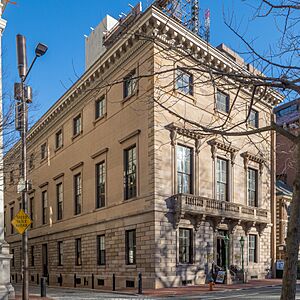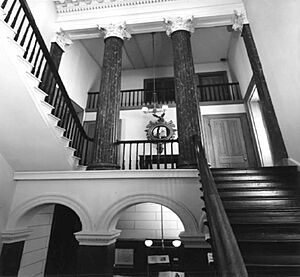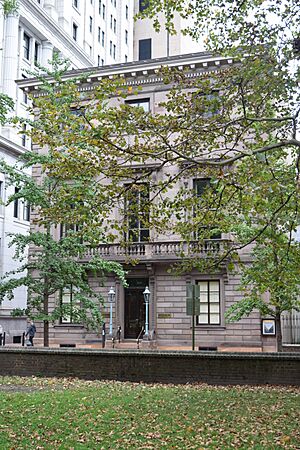Athenaeum of Philadelphia facts for kids

The Athenaeum of Philadelphia in 2024
|
|
| Location | 219 S. 6th St. Philadelphia, Pennsylvania, U.S. |
|---|---|
| Architect | John Notman |
| Public transit access | |
| Lua error in Module:Location_map at line 420: attempt to index field 'wikibase' (a nil value). | |
| Built | 1845 |
| Architectural style | Italianate |
| NRHP reference No. | 72001144 |
| Significant dates | |
| Added to NRHP | February 1, 1972 |
| Designated NHL | December 8, 1976 |
The Athenaeum of Philadelphia is a special library and museum in Philadelphia, Pennsylvania, that was started way back in 1814. It is located in the historic Society Hill neighborhood. The word "athenaeum" comes from a school in ancient Rome and means a place for learning.
The Athenaeum's goal has always been to collect items related to American history and art, and to share knowledge with the public. Its collections are famous for materials on architecture and interior design, especially from the years 1800 to 1945. It holds about 180,000 architectural drawings and over 350,000 photographs from many American architects.
Since 1950, the Athenaeum has also given out a yearly award for great books of fiction and non-fiction.
Contents
A Landmark Building
The Athenaeum's building is a work of art itself. It was designed in 1845 by an architect named John Notman. He used a style called Italianate, which was inspired by grand Italian palaces, or palazzos.
It was one of the first buildings in Philadelphia to be made of brownstone, a type of reddish-brown sandstone. The original plan was to use marble, but brownstone was less expensive.
Because of its beautiful design and its importance as a place of learning, the building was named a National Historic Landmark in 1976. Today, it's also a museum that shows American art and furniture from the early 1800s.
Working with Penn Libraries
In 2019, the Athenaeum partnered with the libraries at the University of Pennsylvania. This partnership allows students and members from both places to borrow books from each other's collections. It also makes the Athenaeum's amazing collection on architecture and art easier for more people to find and study online.
The Athenaeum Literary Award
Since 1950, the Athenaeum has given out the Athenaeum Literary Award to honor talented authors from the Philadelphia area. The award is for outstanding books of fiction or non-fiction written for adults.
The award was started by Charles Wharton Stork, who was a member of the Athenaeum's board for almost 50 years. Over the years, many well-known books have received this prize.
Notable Winners
Here are a few examples of books that have won the award:
- 1954: The Night of the Hunter by Davis Grubb, a classic thriller.
- 1967: The Fox and the Hound by Daniel P. Mannix, the book that inspired the famous Disney movie.
- 1981: The Chaneysville Incident by David Bradley, a powerful novel about history and family.
- 1999: Time, Love, Memory by Jonathan Weiner, a science book about how genes affect behavior.
- 2007: Finn: A Novel by Jon Clinch, a story that imagines the life of Huckleberry Finn's father.
- 2018: Circe by Madeline Miller, a bestselling novel based on Greek mythology.
See also



